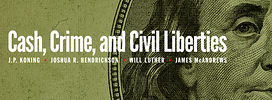One of the main topics of our discussion has been the fraction of law-abiding citizens who would hold the new “supernotes” and the corresponding welfare effects. I think that this issue is important, but not for the reasons that have so far been discussed. My primary motivation is to discuss the idea that the fraction of law-abiding citizens who use the notes is endogenous to the “supernote” tax proposal.
In assessing the costs and the benefits, J.P. Koning noted that alcohol taxes do not discriminate based on the behavior of the purchaser. The implication seems to be that it is okay to tax both good and bad actors as long as the benefit of the reduction in “bad” behavior is greater than the cost of the reduction of “good” behavior. To determine whether the supernote tax policy provides a net benefit, we would need to determine the fraction of law-abiding individuals holding supernotes, the fraction of criminals holding supernotes, and their respective sensitivities to the tax. Will Luther countered that either the supernotes provide a social benefit and shouldn’t be taxed, or that supernotes should not be issued at all. The trouble I have with this debate is that the fractions of the respective groups holding the supernotes are not something that can simply be taken as given. In reality, the fraction of each group is a function of the size of the tax. In fact, the success of Koning’s supernote proposal seems to completely rely on this point.
Consider a textbook example of social cost. Suppose that there is a factory that pollutes a river. Downstream from the factory is a fishery. If the fishery owns the rights to the river, then this pollution is a violation of its property rights. The factory could pay the fishery for the right to pollute the river, provided the compensation is sufficient to offset the costs of the pollution. In the absence of significant transaction costs, this is what we would expect to happen given the initial distribution of property rights. In my last essay, I pushed back on the idea of illegal trade as necessarily fitting the definition of an externality. Nonetheless, if we accept the premise that illegal trade generates some sort of social cost, then there should be a similar solution to this problem. For example, criminals might be willing to pay law-abiding citizens to ignore the illegal activity. If the payment is sufficient to offset cost imposed on law-abiding citizens, then law-abiding citizens will be sufficiently compensated.
Of course, practically speaking, we should not expect this to occur in reality. The reason is that criminals tend to hide their activity. We would therefore never expect a group of criminals to come forward, volunteering their identities and their role in illegal activity, and offer compensation to law-abiding citizens. Nonetheless, there might be a role for policy here. The role for policy can be seen from a mechanism design approach to the problem. In other words, we know the desired allocation, but we need to design a policy that reveals types in order to implement that allocation.
One policy that can potentially accomplish this goal is to introduce a supernote that circulates alongside traditional currency denominations, but earns a different rate of return. The varying rates of return are crucial. Since criminals are likely to prefer the use of supernotes, they will be willing to hold these notes at a lower rate of return than law-abiding citizens. It is therefore possible to vary the rates of return on traditional denominations of currency and supernotes to create a separating equilibrium. To put this another way, it is possible to vary the relative rates of return such that only law-abiding citizens hold traditional denominations and only criminals hold the supernotes. By having a positive rate of return on traditional denominations and a negative rate of return (a tax) on supernotes, policymakers can create precisely the type of transfer from criminals to law-abiding citizens described above.
This example highlights that introducing a supernote that is taxed need not have any effect on law-abiding citizens provided the tax is sufficiently large that only criminals decide to use them. Thus, contrary to Koning’s assertion, whether the policy is a good idea does not depend on the fraction of supernotes held by the respective groups. Also, contrary to Will Luther’s claim, the introduction of the supernote in this instance is welfare-improving (given the premise that illegal trade creates a social cost) because it allows policymakers to engineer a transfer from criminals to law-abiding citizens that would not be available otherwise.
Nevertheless, there is a caveat to this example. Criminals would prefer supernotes because of the high denominations. If the tax is sufficiently high, however, the cost will not be worth the benefit. With the term “sufficiently high,” the devil is in the details. The existence and the creation of alternative media of exchange will put a limit on the tax. If the tax is too high, criminals are likely to switch to traditional denominations, cryptocurrency, or even create their own payment system. To implement Koning’s proposed policy requires that policymakers are able to thread a needle. These policymakers need to implement a tax that is high enough to prevent law-abiding citizens from using it (thereby facilitating the transfer), but not so high that criminals will choose an alternative.

